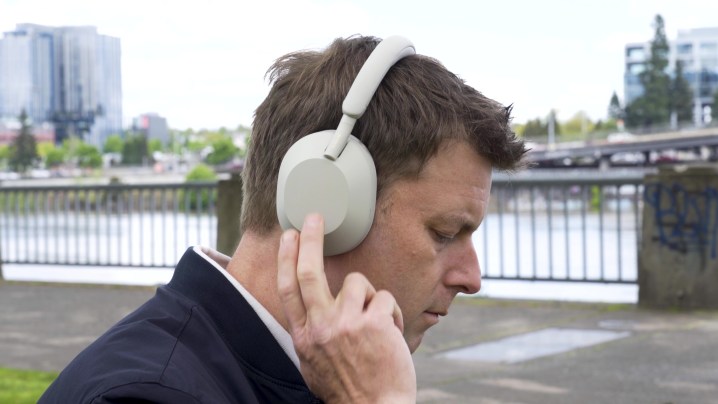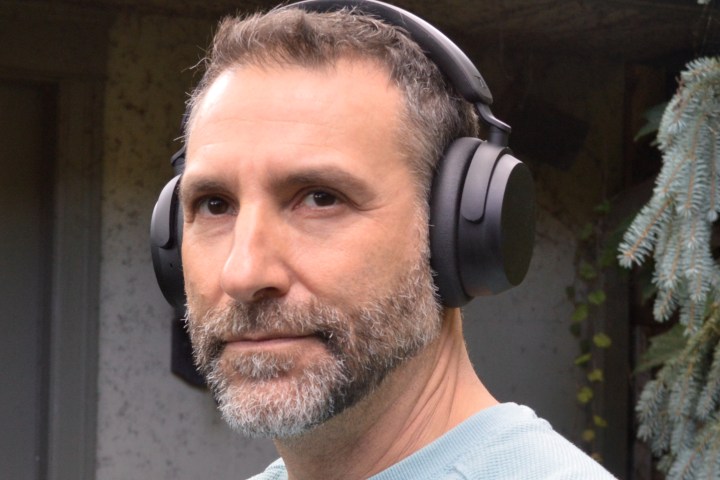
The world can be a very noisy place. But for the neurodivergent — people with autism, ADHD, anxiety, and sensory needs — the cacophony can be uncomfortable and often excruciating. Daily stimuli such as loud sounds, lights, voices, or even the rabble of a coffee shop can be difficult to filter out, causing anxiety and making it hard to concentrate, work, or study.
Members of these groups are oftentimes unable to go to concerts, sporting events, or even out for dinner with family and friends, and this can lead to feelings of social isolation and depression. As part of our Tech for Change series, we took a look at a common tech tool that has been bringing those with sensory issues some welcome calm, quiet, and freedom: headphones.
While we know a thing or two about what makes a good pair of headphones, we can’t think of a better use case for these ubiquitous sound-delivery devices. And whether we’re talking about a pair of passive sound-isolating earmuffs that don’t deliver sound at all or a set of active noise canceling (ANC) cans with the latest audio tech, experts — from psychotherapists to nonprofits working to make concerts sensory inclusive (and even the makers of headphones themselves) — have discovered how headphones can help quiet what can be an overwhelming world and allow those in need to focus and function better.
What does it mean to have sensory needs?
The inability to cope with or process various sensory situations can affect a wide range of individuals who have a variety of conditions and disorders. They range from the neurodivergent (a nonmedical umbrella term that refers to those with a neurological function that is considered different from the norm) to those with autism, attention-deficit/hyperactivity disorder (ADHD), post-traumatic stress disorder (PTSD), Parkinson’s disease, cystic fibrosis, stroke-related issues, dementia, and more.
A person with sensory needs might find it difficult to cope with triggers such as sound, light, touch, taste, or smell, but it’s important to note that everyone is different. Those with ADHD, for example, can have difficulty paying attention and staying focused, and they can be easily distracted by sounds that can throw them off or shut them down completely.
Janine Cole, a registered psychotherapist (qualifying) from Toronto, knows about this all too well. Cole works with a range of patients, including those with anxiety and ADHD, and has a teenaged son with the disorder.
“He’s easily overwhelmed or distracted by either loud noises or a cacophony of different voices, especially in crowded, noisy rooms,” Cole says. “When he was doing online school during the pandemic, it was really hard for him to focus. He got easily distracted and it was difficult for him to sit still, more so than in the classroom. It meant he had to avoid certain situations and struggled to regulate himself when we did take him places. We used to take him to concerts, but he usually just ended up falling asleep.”
How can headphones help?
It was actually at a concert where a friend of Cole’s brought a couple pairs of noise-canceling headphones and offered a set to her son after they noticed he was getting overwhelmed. “He was then able to sit on the floor and stay for the rest of the concert. No ‘Can we leave yet?’ or ‘When is it over?’” Cole says.
Soon after that incident, Cole’s son started regularly wearing ANC headphones during his online school sessions. “It was then that I saw them as an integral part of his ability to function in times he needed them,” she says. “They cancel out the environmental noise that would normally overwhelm him, causing him to shut down or have to remove himself and go somewhere quiet to be alone.

“When he was doing online school, he had them on and he’d be in the backyard hitting a stick against the ground. At first, I thought he wasn’t absorbing anything, but then he’d run back in, unmute his computer and answer the question his teacher had asked. I was so surprised. All this time, I thought he was checked out, but he was actually really focused.”
It’s been years now, and Cole’s son continues to use his ANC headphones to help him focus while doing homework and working on school assignments. “They’ve helped him regulate and be more present and participate in events he normally would have dreaded or had to avoid,” Cole says.
But as a therapist, Cole is also quick admit that a pair of headphones can also be helpful to anyone, neurodivergent or not, and has even recommended them to clients who sometimes get overwhelmed and need a way to calm down and focus.
“I suggested them to a client of mine who was going back to work after a period of being off,” she says. “They were concerned about being overstimulated and I suggested putting them on during breaks to reset and help them make it through the first few days. I’ve tried them, too, and it’s like instantaneous peace.”
You don’t need be a registered psychotherapist to understand that a little peace and quiet can do wonders, even if it comes by way of a piece of technology. Take it from our own Andy Boxall, who wrote about how his ANC headphones helped him create his own “Fortress of Solitude” and lower his anxiety levels during the pandemic. “I knew I needed to take back some control in order to lower my anxiety, and I wasn’t quite at the point where I wanted to become a hermit. So, I turned to tech,” Boxall wrote.

Will any old pair of headphones do?
We’ll be the first to tell you that all headphones are not created equal, and we definitely look at them with a scrutinizing eye, whether it’s the best wireless earbuds or the best noise-canceling headphones you can buy. But it doesn’t matter if you’re a person with sensory needs or not, everyone is different, as is how different people use their headphones.
Who better to talk to about this than the headphone makers themselves? Since the company was founded in 2014, Puro Sound’s volume-limiting headphones have been a good choice for parents wanting to protect their kids’ hearing. Back then, their mission was focused on reducing the instances of Noise Induced Hearing Loss (NIHL) around the world. But in more recent years, the company discovered that its products could be of great benefit to those with sensory needs, a fact that has influenced its products designs and features.
“[The realization] did influence some of our designs and features we offer,” Davis Camarigg, PuroSound’s vice president of sales, tells Digital Trends. “The easiest example to point out is our PuroCalm Earmuffs. This is a noise-isolating headset that is designed to block out noise in loud environments. This product helps provide people with neurodivergent issues a calming environment, no matter where they are.”

Modern headphones are compact, comfortable enough to be worn for long periods of time and have all kinds of design elements and features that can cater to these unique needs. Some neurodivergent people might simply prefer a pair of headphones that block outside noise, while others might need the consistency or predictability that their favorite music or white noise provides.
For the latter, they don’t even have to be headphones at all. Puro’s PuroCalm Earmuffs don’t even play music, but their snug, over-ear fit offers a high level of passive noise cancellation/isolation (and hearing protection). Passive noise cancellation isolates naturally by creating a good seal around the ear. Earmuffs are similar to ear protection headsets you might see on noisy work sites or the airport tarmac and could be an ideal choice, but they do not play music.
For that, the next step would be a pair of passive noise-canceling headphones that also offer a decent seal, but can be used to play music and games, as well as for other functions. They come in wired and wireless (Bluetooth) varieties, as well as over-ear and earbud formats, and are more suited for creating that seal than, say, a pair of on-ear headphones that do not cover your ears. Headphones with passive sound isolation are often more cost-effective than more technologically advanced ANC headphones.
ANC headphones, on the other hand, provide one of the best ways to block outside noise and bring the calm. We have a full explainer on how the tech works, but it essentially employs microphones built into the headphones’ earcups that listen for outside sound and noise. That noise is instantaneously analyzed and processed into soundwaves that are the exact opposite of the noise, effectively canceling it out before the sound reaches your eardrum. It’s kind of magical, but the sensation can take some getting used to and some people don’t like using it for long periods of time. If that’s the case, you can just turn it off. ANC can also be found in earbud, on-ear, and over-ear formats, as well as in wired and Bluetooth models.
Decisions, decisions

Whether you opt for a pair of headphones with passive noise cancellation or with ANC, choosing is easier said than done. Believe us, we know. The ultimate choice will come down to personal preference, but there are some basics to keep in mind. Luckily, we have Simon Cohen. Digital Trends’ headphone expert has reviewed hundreds of pairs of the listening devices, so we asked him for some buying advice.
“The number one consideration is comfort. If they don’t fit well, or cause pressure points over time, you’re less likely to want to wear them. And that defeats the purpose of buying headphones in the first place,” Cohen says.
Your next priorities will entirely depend on how, when, and where you see yourself (or your loved one) using them, Cohen says. ANC headphones can add an extra layer of quiet in any scenario, but excel in noisy environments. But Cohen says to beware of the possibility of hiss. “Some ANC systems can actually introduce a bit of unwanted noise, particularly when there’s no music playing. So, if your sensory needs require true silence, audible hiss could be worse than no ANC at all.”
Battery life is also a huge consideration for any pair of headphones, particularly those with power-hungry ANC. If you want to use your headphones all day, make sure they have enough battery life to do so. Luckily, most modern ANC headphones can last upwards of 20 hours on a charge, with some now pushing the 70-hour mark. Most wireless headphones also come with an analog cable for wired listening, which can come in handy if the battery dies. Be sure to check before you buy, though.
Being a headphone reviewer, Cohen also knows a thing or two about protecting your hearing. “If you or your child are going to be listening to music, it’s vital that you have a way to control the maximum volume,” he says, adding that opting for headphones with built-in volume limiting is a great choice for kids.
Finally, Cohen says to consider the headphone’s controls. “Some headphone controls are woefully unintuitive. Be especially wary of touch controls. When they work, they’re great, but in general, a set of physical buttons will be easier to use.”
Taking the calm beyond just headphones

One of the biggest benefits of headphones for those with sensory issues is that they’re compact, portable, and can be easily taken anywhere, which make them such a valuable tool. “Auditory stimuli can be particularly difficult to avoid in certain situations. You can close your eyes, but you cannot close your ears,” says Camarigg. “Our products can help lighten the burden for some of these individuals and help to provide a soothing environment no matter where they might be.”
But what happens when headphones aren’t available? The world is slowly, but surely becoming a more hospitable place for the neurodivergent, with a variety of public and commercial environments, such as movie theaters, starting to offer spaces and amenities for those with sensory needs.
Alabama-based not-for-profit KultureCity has been at the forefront in this initiative for a decade with its “Sensory Inclusive” certification and events around the world. KultureCity works with organizations and companies to provide accommodations for people with sensory challenges, such as ADHD, autism, PTSD, and dementia.

Companies such as Lego have partnered with KultureCity to offer sensory-inclusive experiences for those who need them in their retail locations in the U.S. and Canada. Kids and adults can go to the stores marked with KultureCity’s heart-and-headphone logo, and ask for a “sensory bag” that includes various tools like fidget toys, strobe reduction sunglasses, and, yes, a pair of Puro Sound’s “noise-reducing” PuroCalm Earmuffs. Customers can use the tools while in the store, and its employees are also trained to recognize customers who may need help and offer them support.
“Sound is very subjective. And that translates into different environments, like a Lego store, arenas, or a zoo,” KultureCity Executive Director Uma Srivastava tells Digital Trends. “A different sound might trigger an individual. Depending on the pitch, it might make them a bit more sensitive, or it could bring back a negative memory. Or another example is, if you’re going to an NBA playoff game, they’re going to have all these amazing announcements and music and pyrotechnics and all the bells and whistles. You can’t necessarily go up to guest services and say, ‘Hey, it’s a little too loud. Can you please turn it down?’ These headphones allow individuals to modify their environment as they need.”
Public spaces and even concerts are also getting up to speed. The Indianapolis International Airport, for example, attained KultureCity’s certification in 2023 and began offering sensory rooms with noise-canceling headphones and sensory bags.
Big-name stars are showing their support, too, with celebs like Jason Isbell, Ken Jeong, Randall Park, and Simu Liu sitting on KultureCity’s board and acting as spokespeople. But perhaps its most high-profile partnership is with global superstars Coldplay, whose ongoing Music of the Spheres world tour continues to offer fans in need a safe “sensory refuge station,” which is a dedicated calming area that offers sensory bags.
“We will now be entering year two of our partnership with Coldplay. They put us on their tour indefinitely, because they find the value in that,” Srivastava says. “The sensory rooms allow fans to associate with the music and be able to come in person and enjoy that. If you’ve ever been to a Coldplay concert, it’s an experience.” Other artists have started including KultureCity sensory rooms at their shows, including U2, who had one during their residency at the Las Vegas Sphere.
The future is getting quieter
Since its founding 10 years ago, KultureCity has helped implement more than 900 sensory-inclusive spaces in more than five countries. But even after a decade, Srivastava shares that KultureCity’s biggest challenge is still acceptance.
“When we started, we had a lot of comments come to us saying, ‘Well, if it’s too loud for them or if they get too anxious, why are they going? Why can’t they watch the game at home? Why can’t they watch the concert at home?’ And that’s not the solution,” Srivastava says. “That conversation has definitely decreased, but I think the biggest challenge for us today is still educating people and letting them know that everybody deserves the same access, the same opportunities, whether they have a sensory need or not.”
Camarigg says that the headphone industry can also do more to raise awareness and develop solutions to benefit those with sensory needs. And while he believes that the technology is getting better and options such as noise-isolating earmuffs, ANC and noise-limiting headphones are a great start, there’s still work to be done.
“I believe this is all ultimately a win. At the same time, the vast majority of headphones can reach volumes in excess of 100 decibels, which can be damaging to ears and easily overstimulate neurodivergent people,” Camarigg says. “I believe it would be beneficial if more headphone companies disclosed what their maximum volume levels are so people can be aware and informed when they make a purchase.”
In an ideal world, technology should always be used as a force for good. If a pair of headphones can play a small role in making the world calmer, less stressful, and more accessible for those sensitive to the sounds around us, then we’re on the right track.




